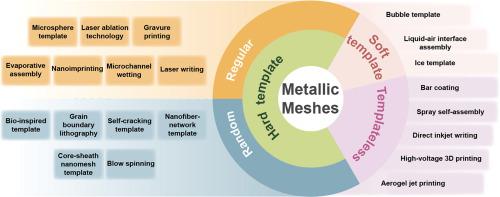当前位置:
X-MOL 学术
›
Mater. Today
›
论文详情
Our official English website, www.x-mol.net, welcomes your feedback! (Note: you will need to create a separate account there.)
Metallic meshes for advanced flexible optoelectronic devices
Materials Today ( IF 24.2 ) Pub Date : 2024-02-03 , DOI: 10.1016/j.mattod.2024.01.006 Yufan Zhang , Zeren Lu , Xinran Zhou , Jiaqing Xiong
Materials Today ( IF 24.2 ) Pub Date : 2024-02-03 , DOI: 10.1016/j.mattod.2024.01.006 Yufan Zhang , Zeren Lu , Xinran Zhou , Jiaqing Xiong

|
Metallic meshes (MMs) are promising for replacement of traditional brittle metal oxide conductors to serve as flexible transparent devices for applications such as environment, energy, display, and human–machine-environment interface. The diversities of MMs in materials, fabrication mechanisms, geometrics and performances extend their applications, however the systematization of this field is rarely concerned. Here, this article summarizes fabrication strategies of MMs in terms of using hard or soft templates, which produce regular-patterned meshes or random-patterned meshes, emphasizing large scale production technology free of templates would lead the development of MMs. Secondly, mechanisms and strategies are highlighted in terms of enhancement of MMs in optoelectronic properties, thermal, chemical, and mechanical stability that are crucial for adapting different application scenarios. Accordingly, the representative applications of MMs in filters, shielding materials, nanogenerators, supercapacitors, solar cells, light-emitting devices, electroluminescent devices, smart windows, thermal management equipment, sensors, and touch panels are introduced, reflecting their respective advantages in diverse applications. Finally, promising solutions to balance the optoelectronic properties and the stability and durability of MMs are proposed to adapt to complex and extreme applications. It is convinced that this review can provide a comprehensive understanding to guide and promote the future development of flexible optoelectronic devices.
中文翻译:

用于先进柔性光电器件的金属网
金属网(MM)有望替代传统的脆性金属氧化物导体,作为柔性透明器件,用于环境、能源、显示和人机环境界面等应用。 MM在材料、制造机制、几何形状和性能方面的多样性扩展了它们的应用,但该领域的系统化却很少被关注。在此,本文总结了MM的制造策略,即使用硬模板或软模板生产规则图案网格或随机图案网格,强调无模板的大规模生产技术将引领MM的发展。其次,重点介绍了增强MM的光电性能、热稳定性、化学稳定性和机械稳定性方面的机制和策略,这对于适应不同的应用场景至关重要。据此,介绍了MM在滤波器、屏蔽材料、纳米发电机、超级电容器、太阳能电池、发光器件、电致发光器件、智能窗、热管理设备、传感器和触摸屏等方面的代表性应用,体现了它们在不同应用中各自的优势。最后,提出了平衡MM的光电特性和稳定性和耐用性的有前途的解决方案,以适应复杂和极端的应用。相信本次综述能够提供全面的认识,以指导和促进柔性光电器件的未来发展。
更新日期:2024-02-03
中文翻译:

用于先进柔性光电器件的金属网
金属网(MM)有望替代传统的脆性金属氧化物导体,作为柔性透明器件,用于环境、能源、显示和人机环境界面等应用。 MM在材料、制造机制、几何形状和性能方面的多样性扩展了它们的应用,但该领域的系统化却很少被关注。在此,本文总结了MM的制造策略,即使用硬模板或软模板生产规则图案网格或随机图案网格,强调无模板的大规模生产技术将引领MM的发展。其次,重点介绍了增强MM的光电性能、热稳定性、化学稳定性和机械稳定性方面的机制和策略,这对于适应不同的应用场景至关重要。据此,介绍了MM在滤波器、屏蔽材料、纳米发电机、超级电容器、太阳能电池、发光器件、电致发光器件、智能窗、热管理设备、传感器和触摸屏等方面的代表性应用,体现了它们在不同应用中各自的优势。最后,提出了平衡MM的光电特性和稳定性和耐用性的有前途的解决方案,以适应复杂和极端的应用。相信本次综述能够提供全面的认识,以指导和促进柔性光电器件的未来发展。



























 京公网安备 11010802027423号
京公网安备 11010802027423号